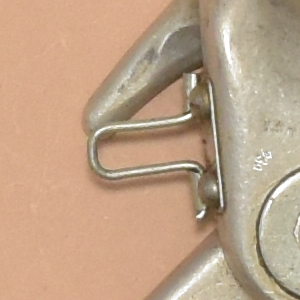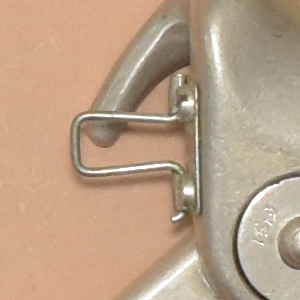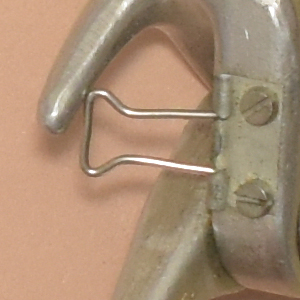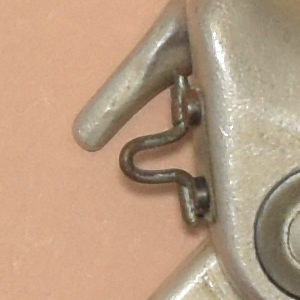Overview
Anton Hiebler partnered with Salewa and developed the Hiebler Steigklemme sometime after his 1961 winter ascent of the Eiger North Face, but the exact year of their introduction is uncertain. His original patent application was filed on July 14, 1961 and he received German Patent #1,229,793 on December 1, 1966. We think that prototypes appeared in 1961 or 1962, but even Salewa does not know for sure. The Hiebler ascender does not appear on the page of the 1962 REI catalog that shows the Jumar, but that does not mean that it wasn't produced at that time. We know that the Hiebler ascender was in production by 1963 at the latest, as it is listed on page 29 of the Summer Sporthaus Schuster catalog that I have in my possession.
Hiebler ascenders had a tendency to come off rope if the user was not careful. Salewa added a safety clip (patented in 1967, German Patent #1,625,860) but this accomplished little. The clip is made of thin wire (about 20% larger than the wire in a large paper clip) and is not particularly effective in keeping the Hiebler on rope. The clip addressed but did not solve the fundamental safety problem with the Hiebler, but then again, no mechanical device ever solves a safety problem: safety is fully the individual user’s responsibility, despite our warped American tort liability lottery system.
Hieblers may come off rope easily, but they had two advantages over the much earlier Jumar ascenders. First, they cost less, and many people value money more than their lives. Second, Hieblers hold well on icy ropes where Jumars tend to slip.
Despite these "advantages," its reputation as a "death clamp" eventually killed the Hiebler. The last time I saw ones listed for sale was in the 1981/82 Caving Supplies (Derbyshire, U. K.) mail order catalog. Their listing was prophetic: "Get some now for your museum." One year later, they were gone.
[ Top
| Version B1
| Version B2
| Version C
| Version D
| Version D repaired
| Return to L.C. Ascenders
]
Version A
(#85, 1525, 2077)
Technical Details
I acquired a pair of Salewa Hieblers, Version A from Darrel Tomer around 1984. I acquired a third one on eBay from Siray Kosek in 2010. I acquired another in 2017 as part of Bob Thrun’s collection. I acquired two more from Bill Liebman in 2017.
The Salewa Hiebler, Version A is 46 mm. tall, 107 mm. wide, 30 mm. thick, and weighs 109 g. Hieblers are made out of a forged aluminum
frame and cam. The frame is open on one side to admit the rope,
and relatively thick (13 mm.) on the back so that the cam will
not twist. The cam appears to have an integral rivet that is staked
to the frame. The cam is spring-loaded. A small hole is visible
on the bottom of the frame. It angles toward the cam pivot. I
suspect it either holds a pin to retain the cam, or provides a
place for the spring to engage.
One side of the arm has "HIEBLER," "STEIGKLEMME," and a parallelogram containing "SALEWA," all raised. The rear has "Jn.u.A.Pat.ang." in raised letters.
Hieblers are old German ascenders - my 1981/82 catalog from Caving
Supplies humorously says "get some now for your museum." They work
on 6 to 11 mm. rope, but not well. One problem is that they rotate
about 90 degrees under load, resulting in a lot of lost motion.
They are easily removed from the rope, even to the point of accidentally
coming off in use.
This is the version shown in German Patent #1,229,793.
|
 |
Warning:
I consider Hieblers to be unsafe. They sometimes come off the rope when a load is applied. |
 |
|
[ Top
| Version A
| Version B2
| Version C
| Version D
| Version D repaired
| Return to L.C. Ascenders
]
Version B1
(#86, 3646)
Technical Details
 I acquired a pair of Salewa Hieblers from Eastern Mountain Sports in 1979 One of these was Version B1 (the other was Version B2). I acquired a second Version B2 pair on eBay from S. Perry in 2024.
I acquired a pair of Salewa Hieblers from Eastern Mountain Sports in 1979 One of these was Version B1 (the other was Version B2). I acquired a second Version B2 pair on eBay from S. Perry in 2024.
Version B1 is 46 mm. tall, 107 mm. wide, 30 mm. thick, and weighs 105 g. It has a thin wire safety held by a stamped plate screwed to the top of the body. The safety has parallel sides with rounded corners.
One side of the arm has "HIEBLER," "STEIGKLEMME," and a parallelogram containing "SALEWA," all raised. The rear has "Jn.u.A.Pat.ang." in raised letters.
Since Hieblers can come off rope, Salewa added a safety clip. The clip is made of thin wire (it is about 20% larger than a large paper clip, according to my micrometer) and hardly does anything. This does not address the fundamental safety problem with the Hiebler.
|
 |
Warning:
I consider Hieblers to be unsafe. They sometimes come off the rope when a load is applied. |
 |
|
[ Top
| Version A
| Version B1
| Version C
| Version D
| Version D repaired
| Return to L.C. Ascenders
]
Version B1
(#86, 1515, 1542, 2078, 3548)
Technical Details
 I acquired a pair of Salewa Hieblers from Eastern Mountain Sports in 1979. One of these was Version B2 (the other was Version B1). I acquired a second Version B2 pair on eBay from Jorge Gutic in 2009. I acquired three more in 2017 as part of Bob Thrun’s collection. I also acquired two Hieblers that are missing their safeties:.one from Philip Harris in 2010 and another from Kelley Deem at the 2022 Old Timers Reunion.
I acquired a pair of Salewa Hieblers from Eastern Mountain Sports in 1979. One of these was Version B2 (the other was Version B1). I acquired a second Version B2 pair on eBay from Jorge Gutic in 2009. I acquired three more in 2017 as part of Bob Thrun’s collection. I also acquired two Hieblers that are missing their safeties:.one from Philip Harris in 2010 and another from Kelley Deem at the 2022 Old Timers Reunion.
Version B is 46 mm. tall, 107 mm. wide, 30 mm. thick, and weighs 105 g. It has a thin wire safety held by a stamped plate screwed to the top of the body. The safety has diverging sides with sharp corners.
One side of the arm has "HIEBLER," "STEIGKLEMME," and a parallelogram containing "SALEWA," all raised. The rear has "Jn.u.A.Pat.ang." in raised letters.
Since Hieblers can come off rope, Salewa added a safety clip. The clip is made of thin wire (it is about 20% larger than a large paper clip, according to my micrometer) and hardly does anything. This does not address the fundamental safety problem with the Hiebler.
|
 |
Warning:
I consider Hieblers to be unsafe. They sometimes come off the rope when a load is applied. |
 |
|
[ Top
| Version A
| Version B1
| Version B2
| Version D
| Version D repaired
| Return to L.C. Ascenders
]
Version C
(#1526)
Technical Details
 I acquired my Salewa Hiebler, Version C on eBay from Siray Kosek in 2010.
I acquired my Salewa Hiebler, Version C on eBay from Siray Kosek in 2010.
The Salewa Hiebler, Version C is 49 mm. tall, 108 mm. wide, 32 mm. thick, and weighs 109 g. The safety clip has a different shape than the one on Version B. It resembles an office binder clip.
One side of the arm has "HIEBLER," "STEIGKLEMME," and a parallelogram containing "SALEWA," all raised. The rear has "Jn.u.A.Pat.ang." in raised letters.
This clip matches the one shown in German Patent #1,625,860. It is no more effective than the one on Version B.
|
 |
Warning:
I consider Hieblers to be unsafe. They sometimes come off the rope when a load is applied. |
 |
|
[ Top
| Version A
| Version B1
| Version B2
| Version C
| Version D repaired
| Return to L.C. Ascenders
]
Version D
(#3514)
Technical Details
 I acquired my Salewa Hiebler, Version D from Wild Gear Deals in 2022.
I acquired my Salewa Hiebler, Version D from Wild Gear Deals in 2022.
Version D is 49 mm. tall, 107 mm. wide, 33 mm. thick, and weighs 110 g.
One side of the arm has "HIEBLER," "STEIGKLEMME," and a parallelogram containing "SALEWA," all raised. The rear has "Jn.u.A.Pat.ang." in raised letters.
This version has a stronger wire clip than the others, but that fails to make the Hiebler any safer. The strength of the clip is not the determining factor, what matters is that the clip can easily be knocked open.
|
 |
Warning:
I consider Hieblers to be unsafe. They sometimes come off the rope when a load is applied. |
 |
|
[ Top
| Version A
| Version B1
| Version B2
| Version C
| Version D
| Return to L.C. Ascenders
]
Version D, Repaired
(#3515)
Technical Details
I acquired this Hiebler from Wild Gear Deals in 2022.
This Hiebler is 49 mm. tall, 107 mm. wide, 33 mm. thick, and weighs 109 g. The safety clip was missing, so I fabricated a replacement.
One side of the arm has "HIEBLER," "STEIGKLEMME," and a parallelogram containing "SALEWA," all raised. The rear has "Jn.u.A.Pat.ang." in raised letters.
I patterned the replacement safety after the one on Version D, using a #15 gauge plated steel hair pin as the source for the wire.
|
 |
Warning:
I consider Hieblers to be unsafe. They sometimes come off the rope when a load is applied. |
 |
|
[ Top
| Version A
| Version B1
| Version B2
| Version C
| Version D
| Version D repaired
]


